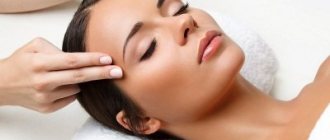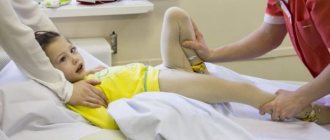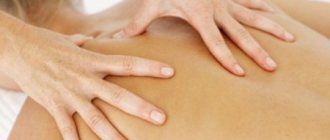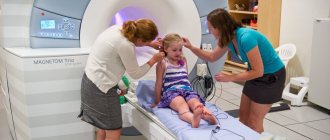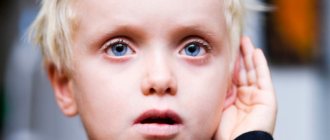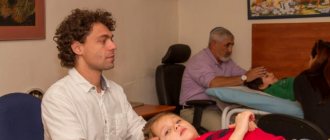Tips and recommendations regarding the correct performance of physical therapy
Therapeutic physical education (PT) helps you learn to control your body.
By doing special therapeutic exercises for children with cerebral palsy, you can improve coordination, inhibition processes, and motor amplitude. The technique is an integral part of an integral complex aimed at reducing the manifestations of the disease caused by cerebral disorders. Therapeutic effects of exercise therapy on the body:
- Strengthens the tissues and organs of the child's body.
- Activates weakened muscles.
- Improves posture.
- Normalizes metabolism.
- Improves the functioning of the brain and circulatory system.
- Promotes overall health.
With regular training, you can achieve the following results:
- developing the child’s necessary basic skills;
- mastering simple work activities;
- servicing yourself without outside help.
It is necessary to begin exercise therapy as early as possible, in the first days of life, gradually complicating the exercises. Moreover, physical education must be carried out if the newborn has no symptoms of cerebral palsy, but is predisposed to its development.
Absolutely all methods when performing physical therapy for cerebral palsy have general recommendations. Classes must be systematic; they must be conducted regularly and continuously. Only such a gymnastics schedule will help achieve a good positive result. A set of exercises should be selected individually by a qualified specialist for each small patient.
In this case, it is necessary to take into account the complexity of the disease and all the features of the course of the disease. Physical activity should gradually increase.
Exercises for children who have cerebral palsy should develop absolutely all muscles and joints. To do this, the gymnastics complex should include the following exercises:
- for muscle stretching;
- to develop muscle strength and sensitivity;
- to develop the sensitivity of the nervous system;
- to strengthen the main muscle groups that take part in all movements;
- so that all organs have good endurance;
- to relax muscles, relieve cramps and spasms;
- to teach a child to walk correctly;
- so that the senses are developed;
- to improve the patient's balance and sense of support.
Also, complex exercise therapy for children with cerebral palsy includes massage procedures. They effectively help patients relax, improve blood circulation, normalize metabolic processes and relieve spasms. To improve the condition of the musculoskeletal system, you need to use several types of massage:
- point;
- segmental;
- classical.
After the first acquaintance with massage techniques, parents can do it to the baby themselves at home. These procedures are taught in specialized courses.
Another set of exercise therapy exercises for children with cerebral palsy has also recently been developed. These procedures include:
- Continuous stroking of the limbs quickly relaxes the muscles.
- Felting has a beneficial effect on large areas of the body.
- Skating is good for the shoulder and hip joints.
- Light tapping promotes rapid muscle relaxation.
- Rubbing the body with the palm of your hand, this procedure perfectly stimulates the muscles of the back, hips and buttocks.
- The strokes are intermittent and keep all muscles well toned.
Important point! All exercises and massages should be dosed; their duration should be increased gradually as the patient’s condition improves.
What is this?
Therapeutic physical education contributes to the development of the child’s abilities to inhibit movements and control them. Exercises improve coordination and increase range of motion.
Therefore, the main goals and objectives of exercise therapy for children are as follows:
- Teaching a child household skills;
- The patient’s knowledge of basic work activities;
- Self-care without the help of parents, caregivers, etc.
The result is the development of new skills, as well as correct movements.
It is very important that exercise therapy classes begin soon after the birth of the child, with gradual complication. Moreover, classes should be started even if the child does not have signs of cerebral palsy, but has a predisposition to its development.
Cerebral palsy: diagnosis and prospects
| Share with friends and colleagues |
Page navigation: Treatment methods for cerebral palsy Classical massage Segmental massage Acupressure Massage up to 1 year Massage after 4 years
Cerebral palsy (CP) is a diagnosis that frightens the vast majority of parents, while the rehabilitation of such a child, his introduction into a group of children and normal communication with peers is possible in many cases. Successful treatment of children with this diagnosis is carried out in outpatient, inpatient and sanatorium-resort settings; these young patients need the help of many medical specialists - a neurologist and pediatrician, psychologist, speech therapist and speech pathologist, physiotherapist and massage therapist and others.
1. genetic (hereditary diseases),
2. physical (radiation, X-ray and electromagnetic radiation),
3. toxic (poisons and industrial highly toxic substances, as well as some medications, which, by the way, are not so few),
4. severe birth injury, in most cases incompatible with life.
According to statistics from different countries, up to 80% of children diagnosed with cerebral palsy suffer from a form of the disease in which intelligence and all leading (cognitive) functions of the brain are preserved - the ability to cognition, thinking, speech, and learning. For such children there is the possibility of rehabilitation, development and social adaptation.
Of course, the life of a child with cerebral palsy, like the life of the entire family, is a special routine in which the leading place is given to therapeutic and restorative measures. With the early start of medical rehabilitation (before the age of 5 years), it is possible to achieve high treatment results in 80% of cases.
With cerebral palsy, dysfunctions of the musculoskeletal system are observed (which is associated with damage to certain areas of the brain), which can manifest themselves to varying degrees: from mild - when the child can move independently and take care of himself, while there is a compulsion of movements, an uneven gait, unnaturalness poses, etc.;
1. preservation of unconditioned motor reflexes (grasping, crawling/pushing away), which are not typical for a normally developing child, which subsequently inhibits the formation of voluntary motor skills (and indicates damage to motor zones in the central nervous system);
2. delayed development of motor activity (holding the head, turning from back to side and stomach, from stomach to back, sitting, crawling, etc.).
In the intellectual development of children with cerebral palsy, the following can be noted: cerebral palsy is a non-progressive pathology, that is, over time, existing lesions in the central nervous system do not worsen, however, if a child with intact intelligence does not receive sufficient development, a regression of intellectual abilities occurs.
That is why it is important to pay special attention to the education of such a young patient. Today, many methods have been developed that allow obtaining excellent learning results, computer programs that promote the development of children with cerebral palsy (including speech delay). In some European countries, the USA, and Canada, the use of such programs allows a child to attend a regular school and communicate with peers without any problems.
At the initial stages of treatment, after the diagnosis and form of cerebral palsy have been clarified, medical techniques, an integrated approach to therapy, and the use of modern medications are of key importance. Such a multidisciplinary approach with the participation of specialized medical specialists - a neurologist, orthopedist, pediatrician, physiotherapist, massage therapist, speech pathologist, speech therapist - is possible in a specialized hospital or sanatorium.
1. physiotherapeutic techniques: balneo-, light-, magneto-, halo- and reflexology;
2. complex drug treatment (nootropic, neurometabolic, vascular, vitamin and other drugs);
3. orthopedic correction;
4. different types of massage, which is carried out by a medical massage therapist according to the strict instructions of the attending physician;
5. physical therapy (physical therapy);
6. dynamic proprioceptive correction (DPC);
7. transcranial polarization (TCMP);
8. hippotherapy (specially trained horses participate in the treatment);
9. diet therapy and other sanatorium-resort and rehabilitation techniques.
It should be noted the particular benefits and therapeutic value of massage for cerebral palsy. The overall positive effect of massage is to improve blood and lymph flow, activate metabolism in tissues, have a reflex effect on the nervous system and internal organs, increase muscle mass and the adaptive capabilities of the child’s body.
The specific effect of massage in cerebral palsy is aimed at relaxing spastic muscles (stroking, rolling, shaking, vibration, punctuation), stimulating weakened muscles (stroking, rubbing, pinching, tapping, shading, puncturing). The massage is performed on certain muscle groups; it is often recommended to combine it with breathing movements.
Before moving on to exercises, it is important for parents to understand that physical therapy has several independent directions. However, they do not always relate to gymnastics. Other therapeutic forms are also used that are aimed at improving the child’s well-being.
The following groups of exercises are distinguished:
- support and improvement of motor function.
- strengthening joints.
- improving facial expressions and control over emotions.
- breathing correction.
- abdominal muscles.
- torso and neck area.
The treatment complex itself may consist of the following aspects. Stretching for the child, walking and body control may be used. By the way, quite often doctors recommend performing yoga, naturally, focusing on the patient’s well-being.
What exercise therapy exercises for cerebral palsy can be done at home?
Of course, it is best to take exercise therapy courses in specialized medical or sports centers, however, not everyone has the physical or financial opportunity to do this. Also, many parents would not like to limit themselves to only classes in swimming pools or gyms, wanting to continue working with their children at home.
Therapeutic physical education is not such a difficult matter, since a child with cerebral palsy perceives even ordinary everyday actions as a healthy person doing sports. Most parents of sick children make a huge mistake, trying to protect him from difficult physical activities and help him in everything: thus, the disease only gets worse.
The child must himself do everything that he is at least physically capable of. Even if it’s difficult for him or he doesn’t succeed, this is how his muscles develop, as well as his nervous system, and he learns to take care of himself, to exist in a huge world that he will face more and more often face to face as he grows up.
It is worth remembering that the parent’s task is to ensure that the child does not suffer morally or physically, and not to completely protect him from life or take on all the work to provide for him, because parents are not eternal and it would be better if the baby is prepared for independent life from childhood .
Just like physical therapy, any joint physical activity with children in nature or in the pool will do.
Swimming is a universal method that can be performed not only in a pool, but also in any suitable natural body of water or even in a regular bath, and does not require special medical knowledge or special exercises.
Gymnastics can be done anywhere and anytime. You can use any simple, non-straining exercises for all muscle groups, as well as for individual ones that work worst for the child. Depending on the baby’s condition, even simple flexion and extension of the fingers can serve as a type of exercise therapy if this is difficult for him. You can ask your neurologist about which specific muscles to target with the most active influence.
With cerebral palsy, any physical exercise or activity can be considered physical therapy; a specialist simply knows how to increase their efficiency and enhance the positive effect on the nervous system.
Why is physical activity necessary?
If a child is diagnosed with cerebral palsy, then it will be difficult for him to perform specific actions, and unwanted movements will be carried out involuntarily. This is why therapeutic exercises are required, because it helps strengthen the body and teach a person to control his body. It is important to understand that patients with cerebral palsy must constantly exercise. They are needed not only at an early stage, but throughout life.
When performing physical exercises, it will be necessary to teach the minor everyday skills and abilities. He should consider serving himself as much as possible. In this case, it will be necessary to introduce children to difficulty; this is a separate method of therapy.
In this case, it will be important to follow the specific principles of physical therapy:
- All exercises will need to be performed regularly, because it is extremely important that the classes take place continuously. It should be understood that muscle memory quickly forgets specific moments. Therefore, they must be carried out systematically so that the best result can be achieved.
- Be sure to gradually increase the load. There is no need to immediately move from easy to complex exercises. Everything should happen gradually, because it is not easy for a child to cope with gymnastics.
- Individual approach. If the baby has cerebral palsy, then specific exercises should be selected individually. A group approach is excluded, because it is necessary to take into account the characteristics of the patient.
Naturally, when prescribing exercise therapy for cerebral palsy, it will be necessary to take into account the child’s age and the severity of the disease. If you choose the right treatment complex, then you will be able to achieve various goals. In particular, exercise will prevent the occurrence of adhesions between nerve roots. They will strengthen the body and make the patient healthier.
It will also be possible to activate weakened muscles and eliminate spinal curvature. Another benefit of physical exercise is that it can improve blood circulation and also stimulate brain activity.
How to perform exercise therapy correctly
Most of the exercise therapy is designed specifically for parents with children, since a joint session of restorative gymnastics is designed not only to teach the child to understand his body, but also to teach the parent to understand the body of his child, help the baby control it, learn the amplitude of his physical capabilities, identify specific needs and learn carry out continuous restorative procedures in everyday life.
In addition, the presence of parents improves the child’s morale, makes him more resilient, encourages him to try harder, or consoles him during particularly exhausting exercises or after failures.
The second rule for conducting exercise therapy is the golden mean: on the one hand, the more classes there are, the more effective they will be, simultaneously developing the child’s endurance, but on the other hand, children with cerebral palsy should not be overworked, even if they do not have any concomitant diseases, for example, epilepsy , since muscle overload or mental overload leads to overload of the nervous system, which should not be further injured.
The third rule is constant moral support, focusing on successes and improving morale, which is extremely necessary for a sick child.
Patience is the most important thing parents need when conducting recovery classes. You cannot demand too much from a child or expect instant results, much less focus on failures or scold them for laziness. You need to try to interest the baby as much as possible so that he is less tired or suffers from his inferiority. Only positive motivation and encouragement for success during classes or everyday activities will lead to a positive result.
Basic principles of the technique
- Physical therapy is based on a number of basic principles:
- Classes are held regularly, without absences or long breaks.
- Gradual increase in physical activity.
- Individual approach.
- Conducting classes taking into account the stage of the disease, age, and mental state.
Along with exercise therapy, correctional and educational measures must be carried out to compensate for functional impairments.
Exercise therapy, like other common techniques, is based on a number of principles:
- Regular and systematic exercise;
- No long breaks;
- Gradual increase in physical activity;
- Lack of orientation towards other patients - only individual methods;
- Taking into account the stage of development of the disease, the age of the child, his psychological state.
Correctional and educational work is especially important, because it allows you to compensate for impaired functions. Classes are recommended from an early age. Remember - the sooner the better for the child!
Types of exercises and features of classes
Any health-improving exercises should be selected taking into account the needs of each individual patient. However, each exercise program includes the following types of exercises:
- relaxing;
- helping to improve dynamics;
- stimulating physical activity;
- performed lying down;
- performed while sitting;
- having a gaming orientation.
If gait is difficult, or the patient is unable to walk, the exercise should be carried out near bars or rigid support. At the next stage, the lesson continues near the wall. In order for the center of gravity to be equally distributed on both sides of the body, actions are performed first with some limbs, for example, the right arm or leg, then with others.
Exercises for the development of the musculoskeletal system
If the central or peripheral nervous system is damaged, a disturbance in the movement of the upper or lower extremities may occur - tetraparesis. Appropriate gymnastic exercises can strengthen the motor skills of disabled children and increase the level of control over their actions.
Exercises that improve motor activity:
- Starting position: sitting on your heels. The adult conducting physical therapy puts his palms on his shoulders, then holds the child in the hip area, gradually pushing him to kneel.
- At first, the child sits on his lap. Holding him in the armpit area, you should start moving from side to side so that he learns to independently transfer his body weight to one leg. He tries to tear his other leg away from the fulcrum and spread his arms to the sides.
- You need to turn to face the child sitting on the chair. An adult fixes his legs on the floor with his own and takes him by the hands. The arms are extended forward and upward, so the patient with cerebral palsy will learn to stand up on their own.
- Starting position - standing, feet placed in one line (one after another). You need to take turns lightly pushing the little patient in the back, then in the chest. Such actions will teach him to maintain balance.
- Starting position: standing. Holding the child by the hand, you need to swing him in different directions so that he tries to step on his own.
Lie on your back with a wall or other support nearby. We must try to press our feet onto a hard surface, training our ability to stand firmly on the ground.
As the name suggests, these exercise therapy exercises for cerebral palsy are used to maintain the child’s motor activity. Parents can familiarize themselves with the specific set of exercises that will be used for patients.
Types of exercises:
- The doctor should stand in front of the patient and then place his hands on his shoulders. In this case, the baby should sit on his heels. Now the child must try to kneel from the starting position.
- It is important that the baby learns to transfer weight from one lower limb to the other. The doctor should support the baby by the armpits, while he is from behind. The specialist is obliged to smoothly move the baby to the left and to the right. This is necessary so that a person learns to transfer weight from one leg to the other. When making the transfer, you will need to lift one leg off the floor, with your arms spread to the sides.
- The baby needs to learn to straighten his knees. The child will need to be in a sitting position, while he must be squatting. The specialist must press on the child’s knees with his hands, and then slowly tilt the patient’s torso. In this position, the knees should straighten on their own.
- You definitely need to teach your child to stand up. Starting position – the baby must sit on a chair. In this case, the doctor must stand in front of the minor, while he needs to lightly step on the patient’s feet. Naturally, this should not cause discomfort or pain. The child’s arms need to be raised up, and the specialist should pull them slightly. In this case, you will get up from the chair on your own.
- A child with cerebral palsy needs to practice balance. He should stand with one leg slightly forward. It is important that two adults be present during the exercise. One will stand facing the baby, and the other will be behind him. In this case, you need to make pushes one by one; they are not done diagonally, but directly into the back and chest.
It will be extremely important to teach your baby to take his first steps. He will need to stand, after which the doctor will lightly pull the patient's arm. He needs to be pushed in different directions for him to take a step. It is also important to apply pressure with your feet. The baby needs to lie down and bend his knees. The doctor should ensure that the feet press on the floor surface. This will help improve your support ability.
It is useful to perform rocking exercises directly for the muscles of the torso. The baby will lie on his back, while the doctor fixes the body with both hands. After this, he will begin to perform rocking movements, left and right. After this, you need to use your head, turning it in different directions. Specific exercises will be determined by a specialist, because he must take into account the individual characteristics of the child.
AUXILIARY TRAINERS
As additional accessories, it is recommended to use a mat with a ribbed top and tubercles. The baby must be gradually taught to stomp on it with bare feet.
An expander that helps develop motor skills eliminates spasticity. Previously, they used bags of buckwheat or rice.
Walkers, jumpers. Ordinary ones will not work; it is better to choose ones specially made for children with cerebral palsy and used in exercise therapy. They are produced with an orthopedic insert. Before purchasing, it is important to consult a specialist in order to avoid unexpected consequences.
Exercise therapy programs are always selected by a specialized specialist who takes into account the child’s characteristics.
Let's summarize. Therapeutic gymnastics with systematic exercises gives positive results - systematically practicing at home, the child trains weakened muscles, strengthens the immune system, the body as a whole, normalizes metabolism, improves the functioning of the circulatory system.
For successful treatment, it is necessary to exercise on special simulators, as well as regularly undergo massage treatments.
To begin with, you can use a rubber mat with pimples. The child must be placed on his back, and he can touch the surface of the object with his hands. Thus, tactile contact develops. At this time, the parent can massage the lower extremities.
You can sew a toy from cotton material and fill it with any cereal. Such a thing will develop grasping reflexes and fine motor skills of the hands.
Like all children, they need to exercise using jumpers and walkers. However, these items must meet the requirements of children with cerebral palsy syndrome. All fastenings and materials must be of high quality and durable, because children have poorly developed coordination, and if they fall, they will not be able to protect themselves.
Also a good way to develop and restore the body is a ball pool. In it, the child can relax, touch objects and just have fun. However, you should not use fragile materials that need to be inflated. A child may accidentally fall out of such a pool. The frame must be made of durable material.
All exercises can be performed at home. The main thing is that they meet safety requirements and do not injure the baby. If he does not want to perform some action, then the parent must persuade him to perform it.
However, to arouse interest, it is necessary to present everything as a game. Then the baby will be able to happily do complex exercises.
For classes, you can use a Swedish wall. Thanks to this sports element, a child can develop different parts of the body and strengthen muscles. With its help, you will be able to develop your limbs - there are a large number of actions that can be performed on the wall bars.
However, one child cannot be left on it. All actions are carried out only under the supervision of an adult. Doing it yourself may cause injury. As a rule, this equipment is made of wood.
When performing various actions, you can use special equipment - a Gross simulator. This development is simply irreplaceable for children with cerebral palsy syndrome, since it is designed in such a way that it is impossible to fall in it and injure yourself.
The corset has a beneficial effect on the restoration and correction of posture. With its help, a child can learn many movements. The most important thing is that the baby learns how to walk correctly; a corset is often used when exercising on various exercise equipment. It's great for cycling too.
Exercises to strengthen joints
With cerebral palsy, various joint pathologies, cramps and joint pain are common. Exercises necessary for their development:
- The exercise is performed lying down. One leg needs to be straightened and fixed, the other gradually bent at the knee. If possible, the thigh should be pressed to the stomach, then pulled back.
- While on your side and keeping your knee bent, you need to slowly begin to abduct your hip.
- You need to lean your stomach against the table so that your legs can hang freely, then gradually straighten them.
- The starting position is on your back. First you need to bend your knee, then straighten it as far as possible.
- The starting position is lying on your stomach, with a cushion placed under your chest. Holding the patient's hands, you need to lift the upper part of the body, making slightly jerky springy movements.
- The arm of a child lying on his back must be bent so that his face remains turned in the same direction. Then the limb bends when turning the head in the other direction.
As part of exercise therapy, classes are conducted that develop and strengthen a group of muscles located in the abdominal cavity:
- The child needs to be placed on his knees, pressing his back to your chest, and then you need to bend down with him. In the next step, the legs and pelvic area of the small patient are fixed so that he can rise on his own.
- Starting position: lying on your back, arms pressed to your body. Making swinging movements and not helping yourself with your hands, you should try to roll onto your stomach and back.
- Lying on your back, inhale and exhale, drawing in your stomach as you exhale.
Gymnastics for the pool
Swimming is very beneficial for children with cerebral palsy; it helps them relax and energizes them. Pool exercises:
- A child goes down into the pool and grabs the side with his hands. The legs are alternately pulled back (5 times each). Then the legs are spread to the sides 10 times.
- Turning over with his back to the side, the baby clings to it with his hands, lifts his legs up and spreads them to the sides. Do this 10 times.
- Having laid the patient with his back on the water, you need to let him grab the side. The mother places her hands under the baby's back. Begin by lifting both legs up (10 times), spreading them to the sides (10 times), crossing the legs (“scissors” 10 times).
- Turn the patient over onto his stomach, let him hold the side with his hands, and you support him by the stomach. Do alternating leg lifts 5 times, then sideways 10 times, and bending the knees of each limb 5 times.
- With your child's back against the pool, ask him to take a sitting position. Then he must spin the “bicycle” with his legs in the water.



